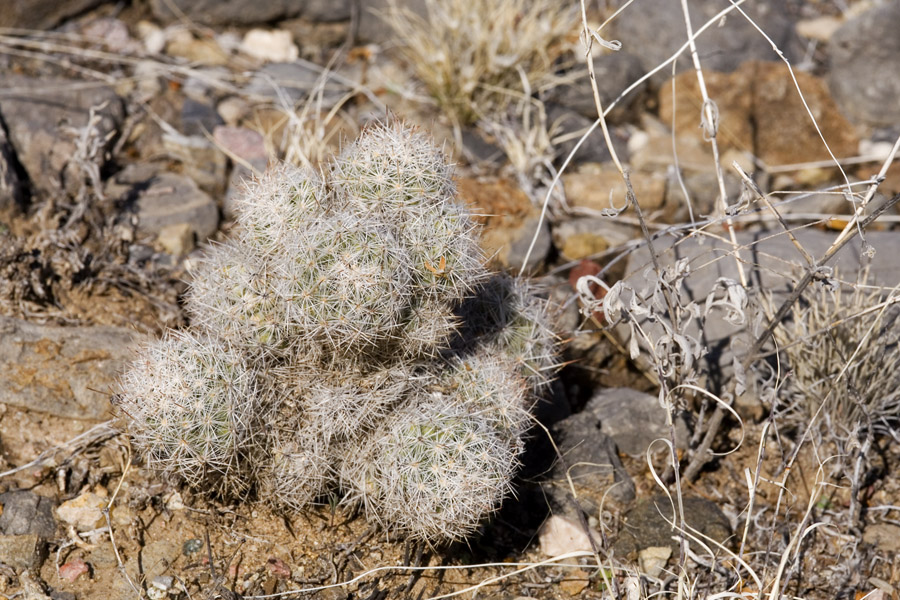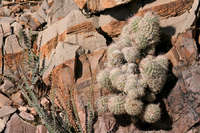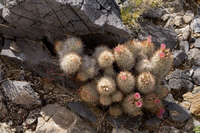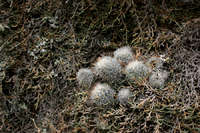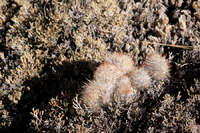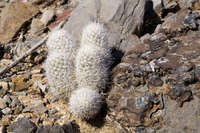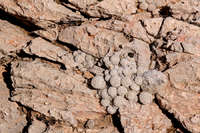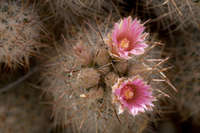Escobaria sneedii
|
|
|
|
Family: Cactaceae
Carpet Fox-Tail Cactus, more...Orcutt's Fox-Tail Cactus, Orcutt's foxtail cactus, Organ Mountain Fox-Tail Cactus, Sacramento Mountain Fox-Tail Cactus, San Andres Mountain Fox-Tail Cactus, carpet foxtail cactus
[Coryphantha organensis Zimmerman, moreCoryphantha sneedii A.Berger, Coryphantha sneedii var. albicolumnaria , Coryphantha sneedii var. guadalupensis , Coryphantha strobiliformis var. durispina (Quehl) L. Benson, Coryphantha strobiliformis var. orcuttii (Bödecker) L. Benson, Escobaria orcuttii Bödecker, Escobaria orcuttii var. koenigii Castetter, Pierce & Schwerin, Escobaria orcuttii var. macraxima Castetter, Pierce & Schwerin, Escobaria organensis (A.D. Zimmerman) Castetter, Pierce & Schwerin, Escobaria sandbergii Castetter, Pierce & Schwerin, Escobaria sneedii subsp. sneedii , Escobaria sneedii var. sneedii , Escobaria villardii Castetter, Pierce & Schwerin, Neolloydia orcuttii] |
Plants branched (with age to 250 branches in some populations), most branches of largest clumps often immature, usually stiff and erect, white, stem obscured by spines. Roots diffuse but ± fleshy or short taproots, largest roots basally less than ± 1/3 of stem diam., often dying in age, root system then diffuse adventitious roots. Stems protruding above ground level for at least 1/2 its length, spheric at first, later cylindric or clavate, 3-27 × 1.3-7(-10) cm; tubercles 3.5-12 × 2.5-6 mm, stiff; areolar glands absent; parenchyma not mucilaginous; druses present, some large, 0.5-1 mm, lenticular, always conspicuous in old parts of stem; pith 1/5-1/3 of lesser stem diam.; medullary vascular system absent. Spines (31-)37-76(-95) per areole, all bright snowy white or, if ± pigmented (in some populations especially on igneous rock), then central spines tan, stramineous, golden yellow, pale chalky pink, pale purplish gray, or pinkish brown (rarely dark brown), palest when fresh, weathering through gray to black, dark tips usually only on largest central spines, usually pink to orange-brown or purplish brown (very rarely blackish); radial spines (18-)25-52(-73) per areole (12-45 per areole on immature branches), ± appressed or tightly appressed, 3-14 × (0.01-)0.05-0.2 mm diam.; subcentral spines (0-)1-5(-10) per areole in adaxial part of cluster; outer central spines (5-)8-17(-23) per areole, appressed or strongly projecting; inner central spines (0-)1-5(-12) per areole, always radiating like spokes on adult plants, porrect (all appressed), straight, longest spines 3-25.5 × 0.2-0.5(-0.6) mm. Flowers nearly apical, 11-28 × 7-25 mm; outer tepals sparsely to densely fringed; inner tepals ca. 11-26 per flower, generally white, cream, pale tan, greenish white, or pale rose-pink, midstripes usually ± sharply defined (sometimes absent), pink often suffused with brown, tan, yellowish, reddish, magenta, purple, lavender, or green, sometimes appearing pale orange proximally, mirroring anthers, or proximally pure white or faintly tinted with green, cream, or dull purplish red to bright pink, 5-14 × 0.8-4 mm; outer filaments white to cream, pinkish, dull purplish red, or magenta (sometimes white proximally, colored distally), usually not contrasting with inner tepals; anthers sulphur yellow or canary yellow; stigma lobes 2-7, white (rarely pale pink or yellowish white), 1-3 mm. Fruits dimo Flowering Mar-Jun; fruiting May-Sep. Chihuahuan desert scrub to conifer woodlands, rock outcrops (rarely alluvial rubble), usually narrowly confined to limestone; of conservation concern; 600-2600 m; Ariz., N.Mex., Tex.; Mexico (Chihuahua). Coryphantha sneedii, in the broad sense, is confusingly variable but less diverse than C. vivipara. Although it is closely related to C. vivipara, certain other species are more difficult to discriminate. Sympatric C. dasyacantha and C. tuberculosa are easily misidentified; identification without seeds or fresh flowers depends heavily on the lenticular druses in the pith and cortex of C. sneedii. The druses, also characteristic of C. vivipara, C. chlorantha, and C. alversonii, are about 0.6-1.0 mm diam. (conspicuous white flecks to the naked eye and strongly granular to the touch, like grains of sand in the tissue), in contrast to the tiny spheroid druses (less than 0.4 mm in diameter) found in most tissues throughout the genus. Sterile specimens of Coryphantha sneedii with large stems sometimes are nearly identical to certain forms of C. vivipara, but all C. vivipara populations have much larger flowers, fruits, and seeds. Young immature plants of C. vivipara lack the diagnostic medullary vascular system that otherwise distinguishes C. vivipara from C. sneedii, and the age at which it is developed may differ from one population to another.
|
|
|
|

